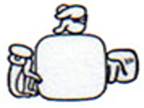| CMGG entry for syllabogram t'a
|
|
Variant: o-like
TOK.p16.r4.c3 BMM9.p6 ? t’a?
Gronemeyer-FtG.p2.fig1c Gronemeyer-FtG.p3.fig3 Gronemeyer-FtG.p4.fig4b IKL Structure 1 UXM Capstone Block C PNG Looted Altar Support A5b <t’a:ba>.yi T’AB.<t’a::ba> t’a:T’AB[*yi]
Gronemeyer-FtG.p6.fig5a block #3 Gronemeyer-FtG.p6.fig5b Gronemeyer-FtG.p6.fig5c XLM Lintel 1 Stone I Block C Museo Amparo Jamb B3 DO 114 A1 <bo:t’a>.ja <bo.ja>:t’a <bo.ja>:t’a
Gronemeyer-FtG.p9.fig9a&b T226 CHN T4L A8 (probably typo è D8) t’a.<T226:li>
· The variant which looks like o is still just a proposal, in Gronemeyer-FtG. Do not confuse it with o and TE’: o In Gronemeyer-FtG.p9.fig9a&c it does indeed look like o; however, o often has a cross-hatched area at the end of the feather, which is absent in this one. o Gronemeyer himself says that this one is very tentative and might in fact be a o after all. If it is a t’a, then he proposes that the “depressed man” glyph be read T’AL. o In Gronemeyer-FtG.p9.fig9b it looks slightly like TE’. · TOK.p16.r4.c3 lists the “tooth + torch” glyph without pronunciation (and so there is no indication if it is a syllabogram or logogram), but BMM9.p6 gives a tentative reading as t’a. The original source of the proposal is not known to me.
|







 =
=

